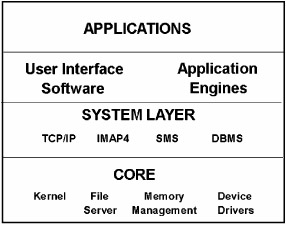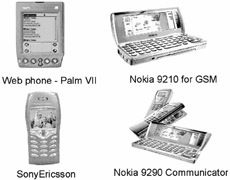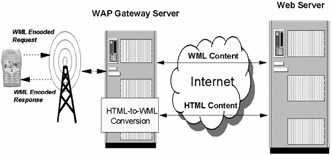1.5 Wireless Devices and Standards
1.5 Wireless Devices and Standards
In this section, we introduce the most-common wireless devices and their applications. We discuss the Wireless Application Protocol, which is a common standard for presenting and delivering services on wireless devices. We describe Java-enabled wireless devices, which use Java technology to run applications on wireless devices.
1.5.1 Wireless Devices
Wireless (or mobile) devices can be classified into six groups: [7]
-
Web phones. A Web phone is most commonly a cellular phone device with an Internet connection. The three major Web phones are the HDML&WAP phone in the United States, the WAP phone in Europe, and the i-mode phone in Japan. Web phones can exchange short messages, access Web sites with a minibrowser, and run personal service applications such as locating nearby places of interest. Web phones operate only when they have a network connection; however, advanced Web phones can run their own applications.
-
Wireless handheld devices. A wireless handheld device (such as Palm) is another common device that can exchange messages and use a mini-browser to access the Internet. Industrial handheld devices, such as Symbol and Psion, can perform complex operations such as completing orders.
-
Two-way pagers. A two-way pager allows users to send and receive messages and provides the use of a minibrowser. They are typically used in business applications.
-
Voice portals. Voice portals allow users to have a conversation with an information service using a kind of telephone or mobile phone.
-
Communication appliances. Communication appliances are electronic devices that use wireless technology to access the Internet. Examples include wireless cameras, watches, radios, pens, and others.
-
Web PCs. Web PCs are standard PCs connected to the Internet that can access mobile services wirelessly.
Wireless devices typically use an embedded real-time operating system. The most-common operating systems for wireless devices include Palm OS (used in Palm handheld devices), Windows CE and Windows NT Embedded by Microsoft (used in a variety of devices such as handheld PCs, pocket PCs, WebTV, Smart Phone, etc.), and Symbian OS.
We present a brief description of the Symbian OS (renamed from Epoc OS) that was used for many years in Psion handheld devices. It is currently used in many wireless devices, including the Nokia 9200 Communicator Series. The architecture of the Symbian OS, shown in Figure 1.12, consists of four layers. The Symbian core is common for all devices and consists of a kernel, a file server, memory management, and device drivers. The system layer consists of data service enablers that provide communications and computing services, such as TCP/IP, IMP4, SMS, and database management. User interface software is made and licensed by manufacturers, e.g., for the Nokia 9200 platform. Application engines enable software developers to create user interfaces. Various applications are at the last layer.

Figure 1.12: The architecture of the Symbian OS.
Figure 1.13 shows several representative wireless devices: the Palm VII, the Sony-Ericsson R520, and Nokia's 9210 and 9290.

Figure 1.13: Contemporary wireless phones and handheld devices.
The Nokia 9290 Communicator is a wireless device that combines wireless phone and handheld device. The user can send and receive e-mail messages with attachments, and can an access the Internet. It has many applications built-in, such as MS Word, PowerPoint, and Excel. An interesting feature is that the user can take notes using the keyboard while conference calling on a built-in, hands-free speakerphone.
1.5.2 WAP
Wireless Application Protocol (WAP) is a de facto standard for presenting and delivering wireless services on mobile devices. It is developed by mobile and wireless communication companies (Nokia, Motorola, Ericsson, and Unwired Planet) and includes a minibrowser, scripting language, access function, and layered communication specification. Most wireless device manufacturers as well as service and infrastructure providers have adopted the WAP standard.
There are three main reasons why wireless Internet needs a different protocol:
-
Transfer rates
-
Size and readability
-
Navigation
The 2G wireless systems have data transfer rates of 14.4 kbps or less, which is much less than 56 kbps modems, DSL connections, or cable modems. Therefore, loading existing Web pages at these speeds will take a very long time.
Another challenge is the small size of the screens of wireless phones or handheld devices. Web pages are designed for desktops and laptops that have a resolution of 640 x 480 pixels. Wireless devices may have a resolution of 150 x 150 pixels, and the page cannot fit on the display.
Navigation is quite different on wireless devices. On desktops and laptops, navigation is performed using point-and-click action of a mouse, while typical wireless devices (specifically phones) use the scroll keys.
Therefore, WAP is created to provide Web pages to typical wireless devices, having in mind these limitations. Instead of using HTML, WAP uses Wireless Markup Language (WML), which is a small subset of XML (Extensible Markup Language). WML is used to create and deliver content that can be deployed on small wireless devices. It is scalable and extensible, because, like XML, it allows users to add new markup tags.
1.5.2.1 WAP Stack
The WAP stack consists of six layers, as illustrated in Figure 1.14.
| Wireless Application Environment (WAE) WML WMLScript |
| Wireless Session Protocol (WSP) |
| Wireless Transaction Protocol (WTP) |
| Wireless Transport Layer Security (WTLS) |
| Wireless Datagram Protocol (WDP) |
| Network Carrier Method SMS USSD CSD IS-136 CDMA CDPD PDC-P |
Figure 1.14: WAP stack consisting of six layers.
-
The Wireless Application Environment (WAE) consists of the tools for wireless Internet developers. These tools include WML and WMLScript, a scripting language (similar to JavaScript or VBScript) that provides interactivity of Web pages presented to the user.
-
The Wireless Session Protocol (WSP) specifies a type of session between the wireless device and the network, which can be either connection-oriented or connectionless. Typically, a connection-oriented session is used in two-way communications between the device and the network. A connectionless session is commonly used for broadcasting or streaming data to the device.
-
The Wireless Transaction Protocol (WTP) is used to provide data flow through the network. WTP determines each transaction request as reliable two ways, reliable one way, or unreliable one way.
-
The Wireless Transport Layer Security (WTLS) provides some security features, similar to the Transport Layer Security (TLS) in TCP/IP. It checks data integrity, provides data encryption, and performs client and server authentication.
-
The Wireless Datagram Protocol (WDP) works in conjunction with the network carrier layer and provides WAP to adapt to a variety of bearers.
-
The Network Carrier Method. Network carriers or bearers depend on current technologies used by the wireless providers.
1.5.2.2 WAP Topology
Figure 1.15 shows a typical WAP topology. The wireless device, which is a WAP client, sends a radio signal searching for service through its minibrowser. A connection is established with the service provider, and the user selects a Web site to be viewed. The URL request from the WAP client is sent to the WAP gateway server, which is located between the carrier's network and the Internet. The WAP gateway server retrieves the information from the Web server. It consists of the WAP encoder, script compiler, and protocol adapters to convert the HTML data into WML. The WAP gateway server operates under two possible scenarios:
-
If the Web server provides content in WML, the WAP gateway server transmits this data directly to the WAP client.
-
If the Web server delivers content in HTML, the WAP gateway server first encodes the HTTP data into WML and then transmits to the client device.

Figure 1.15: The WAP topology.
In both cases, the WAP gateway server encodes the data from the Web server into a compact binary form for transmission over low-bandwidth wireless channels.
With the development of 3G wireless systems, there is a question whether WAP will be still needed. WAP was primarily developed for 2G systems that provide limited data rates of 9.6 to 14.4 kbps. The UMTS network, a 3G wireless system with expected data rates of 2 to 4 Mbps, will resolve the problem of limited bandwidth.
On the other hand, the WAP Forum argues that, even in 3G systems, bandwidth will play a crucial role and that WAP will be beneficial for the UMTS network as well. The WAP features that could be useful for the UMTS network include screen size, low power consumption, carrier independence, multidevice support, and intermittent coverage. Another argument is that new applications will require higher bandwidth and data rates, so WAP will still play a crucial role.
1.5.3 Java-Enabled Wireless Devices
New wireless devices, referred to as Java-enabled wireless devices, have recently emerged. While WAP wireless devices run new applications remotely using WAP, Java-enabled wireless devices allow users to download applications directly from the Internet. In addition, these devices allow users to download Java applets that can customize their devices. Another benefit of Java-enabled wireless devices is that they run applications and services from different platforms.
Java-enabled wireless devices use J2ME (Java 2 Platform Mobile Edition) that allows Java to work on small devices. J2ME includes some core Java instructions and APIs (application programming interfaces); however, its graphics and database access are less sophisticated than in J2SE and J2EE.
Java technology can be implemented either in software or in hardware. In a software implementation, the CPU of the wireless device runs the Java code, while hardware implementation is based on either a specialized Java acceleration chip or a core within the main processor. The hardware approach typically increases the performance of Java applications by running more efficiently and thus reduces power demands. Several companies are currently developing hardware chips that run Java or can be used as Java coprocessors, including ARC Cores, ARM Ltd., Aurora VLSI, and Zucotto Wireless.
Korea's LG Telecom developed the first Java-enabled phone in 2000. Java phones are presently produced by Nextel in the United States, NTT BoCoMo in Japan, and British Telecom. Nokia planned to ship 50 million Java phones in 2002 and 100 million in 2003. [8]
[7]Beaulieu, M., Wireless Internet Applications and Architecture, Addison-Wesley, Reading, MA, 2002.
[8]Lawton, G., Moving Java into mobile phones, IEEE Comput., June 2002, 17–20.
EAN: 2147483647
Pages: 239